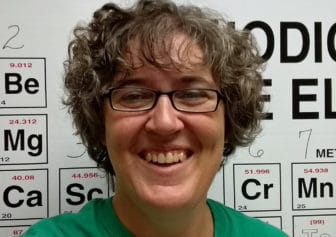COMMENTARY: I have taught science for over 17 years, in New Mexico for almost eight. I currently am the science department lead for Mayfield High school in Las Cruces.
In January and February of 2015, I had the opportunity to join with science teachers, elementary through high school, along with representatives of the national labs, science museums, state universities, and others, to learn about the Next Generation Science Standards (NGSS), compare them to our current standards, and make a recommendation to the New Mexico secretary of education as to adoption. I was then asked to be part of a small (approximately 15) group of teachers tasked with writing a letter to Secretary Skandera with the specific recommendation from the teachers.

Courtesy photo
Erin Taylor
There was a lot of discussion in both groups. It was a diverse group; I had the opportunity to meet teachers from all over the state, small districts and large, from elementary through high school.
Our unanimous recommendation was to adopt NGSS in their entirety. There was never a suggestion that the parts relating to evolution, geologic time or climate change needed to be changed; these were based on accepted science and in no way a shift from the science “positions” of our current standards.
The only proposed alteration was adding in information about New Mexico-specific geology and space history; we ultimately decided that worked better as a local curriculum decision. We expected to begin implementation as early as Fall of 2015.
Instead the Public Education Department (PED), after an inexplicable delay, ignored the advice of pretty much everyone, from teachers, to the national labs, to industry, and released the “STEM-Ready Science Standards,” which is NGSS gutted almost past recognition.
The focus in most of the news has been on the removal of good science related to the age of the Earth and climate change. This, unfortunately, is not the fundamental problem with these new standards, since good science teachers will continue to teach good science.
The far more dangerous issue is that whoever wrote these standards stripped away almost all of what makes NGSS such robust standards. The performance expectations that were used to form the new standards were not designed to be used on their own. NGSS is based upon three dimensional learning.
The first dimension is the disciplinary core ideas (DCIs). These have been arranged not just with a clear development of ideas, but tied to the developmental capabilities of the age of the students. With the DCIs, teachers can see how their particular performance expectations fit into the science story that is told from k-12.
The second dimension is cross cutting concepts (CCCs). While the DCIs develop scientific concepts in a particular discipline, the CCCs help draw the different disciplines together. So as a chemistry teacher I can connect entropy to the energy losses in the food web in biology.
The last dimension, and perhaps the most important, is the scientific and engineering practices. Instead of simply having a unit in the beginning on “The Scientific Method,” these practices are integrated throughout NGSS, from the way it is taught to the way students demonstrate their knowledge.
Does it make a difference? Starting in the Fall of 2015, the Las Cruces Public Schools went ahead and fully implemented NGSS in K-8. I have seen a difference in my own kids’ experiences (currently first, seventh and eleventh grades) in not just what they are taught but how they are taught it. Science is more experiential rather than static. They are expected to take the evidence that they collect and reason from it. And, working with the middle school teachers professionally, there is an excitement about the excellence that comes from NGSS.
Why are we trying to reinvent the wheel? With the significant number of states that have adopted NGSS as written, there is a growing amount of robust supporting material available, much of it for free, that would have to be adapted to these bastardized standards — if it could be used at all. With the budget realities of this state, it seems unnecessary to make changes that will cost us more in the long run in training, curriculum development, and frankly in human capital.
As a teacher and more significantly as a parent I worry about the education that we are providing for the students of this state. There is a lot I can do as a teacher, but the PED needs to step up and do their part, swallow their pride, and adopt NGSS as written. Then we will step up (as we have always done) and do what needs to be done in the classroom. The future of New Mexico can ask for no less.
Erin Taylor is the science department lead at Mayfield High School in Las Cruces, where she resides with her husband and three kids. Her opinions are her own and not necessarily those of the Las Cruces Public School District. Agree with her opinion? Disagree? We welcome your views. Learn about submitting your own commentary here.